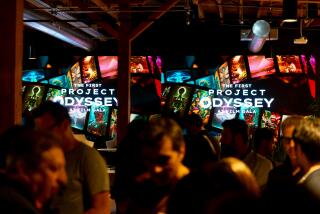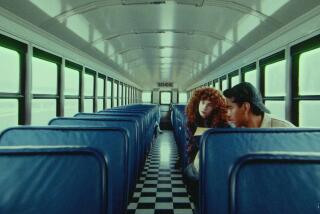
- Share via
An ancient saying posits that you can never step into the same river twice. That also applies to the innovative documentary “Eno.” Filmmaker Gary Hustwit (“Helvetica”), collaborating with creative technologist Brendan Dawes, developed new generative software that draws from more than 500 hours of footage, as well as extensive contemporary interviews, to produce a unique version of the film each time it’s shown.
The approach fits the subject: pathbreaking English composer, producer and thinker Brian Eno, a onetime glam rocker who became famous for his work with Talking Heads, David Bowie and U2, and for christening an entirely new genre of music with his 1978 album, “Ambient 1: Music for Airports.” Now 76, the artist had long waved off filmmaker entreaties but was finally intrigued enough to take part in a technological experiment that mirrored a process he embraced decades ago.
“It opens up a whole other universe of ways to tell stories cinematically,” says Hustwit, joined by Dawes in a recent Zoom conversation from their respective offices in the Hudson Valley and Southport, England. “We come back and watch films again because we love that world that’s been created, but why does that world have to be exactly the same every single time?”

‘I was really satisfied and happy with the final documentary. I’ve seen it twice — and I probably won’t watch it ever again,’ the rock star says.
Since its world premiere at the 2024 Sundance Film Festival, “Eno,” which has been shortlisted for Academy Award consideration, has played in some 500 of its nearly limitless potential iterations (52 quintillion is the official estimate). “It’s a totally different beast,” Dawes says. “That’s the beauty of the system, is that you can keep adding stuff. It’s never really finished.”
In two recent screenings, the film shuffles a wealth of archival material (Eno in his peacock era playing with Roxy Music, in the studio with U2 and Bowie) with more recent conversations at Eno’s home studio, where he talks about compositional techniques, musical influences and creative philosophy. There are glimpses of the artist leading a public sing-along and headlining a speaking engagement before a packed audience. (Tellingly, he reflects on how he nervously prepared a written speech, then discovered he’d forgotten to bring it.)
These components aren’t necessarily any different than those in most music documentaries, although they focus strongly on ideas and concepts rather than a tidy biographical arc. But they are assorted and resorted in abrupt, unpredictable ways that keep the eyes and mind jumping. Hustwit estimates that about 70% of the scenes vary with each version, although the moments that bookend each are consistent.

“People are bored with the streaming experience,” says Hustwit, taking note of media saturation, social and otherwise. “We’re all filmmakers now. We’re experiencing audiovisual material all the time in a way we never have before as a culture, and that’s got to be reflected in the cinema.”
Although it may be easy to assume that the software used for the project might take over the role of a conventional film editor, Hustwit explains it was quite the opposite. “There’s much more editing involved than anything else, because we’re working with much more footage than you’re seeing in a given iteration of the film,” he says. The film’s editors, Maya Tippett and Marley McDonald, were “used to a very different type of storytelling in constructing a documentary. It was combining their need to control the story with Brendan’s desire to make it completely different, completely random, and celebrate that there’s no control. That push and pull allowed us to land on where the film is now.”
Shiori Ito took on a powerful journalist and the Japanese legal system after an alleged date rape, turning the ordeal into ‘Black Box Diaries,’ a documentary that premiered at Sundance.
Audiences everywhere can discover that for themselves on Jan. 24. For the anniversary of its Sundance premiere, “Eno” will be livestreamed globally as part of a 24-hour event scheduled to feature DJ sets, special guests, multiple screenings of the film and a version of its prequel, “Nothing Can Ever Be the Same,” which was presented at the 2023 Venice Biennale as a 168-hour video installation. “It’s like a 24-hour Eno channel,” Hustwit says.
Going forward, the filmmakers are figuring out how to productively share what they’ve learned with other artists. “We want to tell stories,” Hustwit says. “We don’t necessarily want to crunch code. We want to see what the technology that we’ve created can do with other people’s ideas. I’m sure people are going to come up with ideas that are far beyond what Brendan and I could have dreamed.”
More to Read
From the Oscars to the Emmys.
Get the Envelope newsletter for exclusive awards season coverage, behind-the-scenes stories from the Envelope podcast and columnist Glenn Whipp’s must-read analysis.
You may occasionally receive promotional content from the Los Angeles Times.











